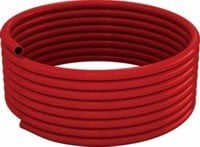Pe-rt Boru 16x2
Giacomini Pe-RT Pipe Prices
 There are two types of pipes that are frequently used in underfloor heating systems with hot water. Polyethylene Raised Temperature Resistant, or Pe-RT Underfloor heating pipe manufacturing uses polyethylene as raw material. With the special methods and high technology used during manufacturing, the highest flexibility is achieved in intermolecular bonds in Pe-RT pipes, while the pressure and heat resistance of the pipe can be preserved to the same extent. Giacomini Pe-RT Pipes have a safety factor of 2.5 and a lifespan of at least 50 years thanks to the molecular structure used in the raw material and the oxygen barrier located at the exact center of the pipe walls.
There are two types of pipes that are frequently used in underfloor heating systems with hot water. Polyethylene Raised Temperature Resistant, or Pe-RT Underfloor heating pipe manufacturing uses polyethylene as raw material. With the special methods and high technology used during manufacturing, the highest flexibility is achieved in intermolecular bonds in Pe-RT pipes, while the pressure and heat resistance of the pipe can be preserved to the same extent. Giacomini Pe-RT Pipes have a safety factor of 2.5 and a lifespan of at least 50 years thanks to the molecular structure used in the raw material and the oxygen barrier located at the exact center of the pipe walls.
The biggest advantage of Giacomini Pe-RT pipe is that the oxygen barrier is in the middle of the pipe walls. This feature prevents mechanical deterioration, especially in sharp turns, when laying pipes in underfloor heating applications. Therefore, since the pipe can be bent in smaller diameters, it is also possible to give smaller modulations.
Polyethylene is used as raw material in polyethylene coss linked, namely Pe-X floor heating pipes. Pe-X pipes are of three types: Pe-Xa, Pe-Xb and Pe-Xc. While the intermolecular bond density is the highest in Pe-Xa pipes, it is the lowest in Pe-Xc. As the bond density increases, the pressure and heat resistance of the pipe increases, but its flexibility decreases. Therefore, since the pipes must be heated and laid in the floor heating installation, it will be affected by both labor and time loss due to the difficulty of installation.
Differences between Pe-RT Pipe and Pe-X Pipe Comparison of Pipes
Pe-RT Pipe: A soft and flexible pipe with dense intermolecular bonds, high resistance to pressure and heat, and very easy to install.
Pe-Xa Pipe: A pipe with dense intermolecular bonds, hard and brittle, high resistance to pressure and heat, but very difficult to install. (Except for Pe-Xa pipes that have been made flexible using advanced technology!)
Pe-Xb Pipe: Intermolecular bonds are sparser than Pe-Xa, a little softer and less brittle than A, less resistant to pressure and heat than A, a little easier to install than A.
Pe-Xc Pipe: Intermolecular bonds are sparser than Pe-Xa and Pe-Xb, softer and less brittle than A and B, less resistant to pressure and heat than A and B. Installation is a little easier than A and B.
Giacomini Pe-RT Pipe Technical Data
Pipe Type: Pe-RT
Density: 0.941 g/cm³
Thermal Conductivity: 0.40 W/(m K)
Coefficient of Expansion: (1.8x10−4)/K
Fracture strength: 36 MPa
Elongation at Fracture: 760%
Modulus of Elasticity: 650 MPa
Pipe Series Standard Dimension Ratio
S = d − s SBO = 2 S + 1 ≈ d
2 · S S
Q: Nominal Thickness of Pipe
d: Nominal diameter of the pipe
α = p · d - s
2 · S




